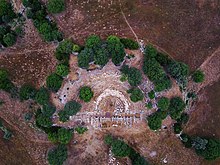

Τέως (in Ancient Greek)
| |

Ruins of the theatre in Teos
| |
|
Shown within Turkey | |
| Alternative name | Teo |
|---|---|
| Location | Sığacık, Izmir Province, Turkey |
| Region | Ionia |
| Coordinates | 38°10′38″N 26°47′06″E / 38.17722°N 26.78500°E / 38.17722; 26.78500 |
| Type | Settlement |
| History | |
| Periods | Archaic GreektoRoman Imperial |
| Cultures | Greek, Roman |
| Associated with | Andron, Anacreon, Antimachus, Apellicon, Hecataeus of Abdera, Nausiphanes, Protagoras, Scythinus |
| Site notes | |
| Condition | Ruined |
Teos (Ancient Greek: Τέως) or Teo was an ancient Greek city on the coast of Ionia, on a peninsula between Chytrium and Myonnesus. It was founded by Minyans from Orchomenus, Ionians and Boeotians, but the date of its foundation is unknown. Teos was one of the twelve cities which formed the Ionian League. The city was situated on a low hilly isthmus. Its ruins are located to the south of the modern town of Sığacık in the Seferihisar district of Izmir Province, Turkey.
Pausanias writes that the city was founded by Minyans from Orchomenus under the leadership of Athamas, a descendant of Athamas the son of Aeolus. Later on they were joined by Ionians and more colonists from Athens and Boeotia.[1] Because it was founded by Athamas, Anacreon also called it Athamantis (Ἀθαμαντίς).[2]
Teos was a flourishing seaport with two fine harbours until Cyrus the Great invaded Lydia and Ionia (c. 546 BC). The Teans found it prudent to retire overseas, to the newly founded colonies of AbderainThrace and Phanagoria on the Asian side of the Cimmerian Bosporus. The port was revived by Antigonus Cyclops. During the times of the Roman emperors, the town was noted for its wine, a theatre and Temple of Dionysus. These are positioned near the acropolis, which is situated on a low hill and had fortifications by the 6th century. A shipwreck near Tektaş, a small rock outcrop near Teos harbour, dates from the Classical period (around the 6th to the 4th centuries BC) and implies trading connections by sea with the eastern Aegean Islands.
It was a member of the Lydian group of the Ionian League, one of the four groups defined by Herodotus, based on the particular dialects of the cities. Vitruvius notes Hermogenes of Priene as the architect of the monopteral temple of Dionysus at Teos.[3]
The modern village of Sığacık is situated close to the ruins of Teos. The interior of what was previously the city has now been intensively farmed, which makes it difficult to excavate the site. Through ploughing, pottery has been brought to the surface of the earth, which has been collected through archaeological survey.
An interesting rental agreement chiseled into stone was uncovered in 2016 in the ruins of Teos.[4][5]

![]() This article incorporates text from a publication now in the public domain: Smith, William, ed. (1854–1857). "Teos". Dictionary of Greek and Roman Geography. London: John Murray.
This article incorporates text from a publication now in the public domain: Smith, William, ed. (1854–1857). "Teos". Dictionary of Greek and Roman Geography. London: John Murray.
| International |
|
|---|---|
| National |
|
| Geographic |
|